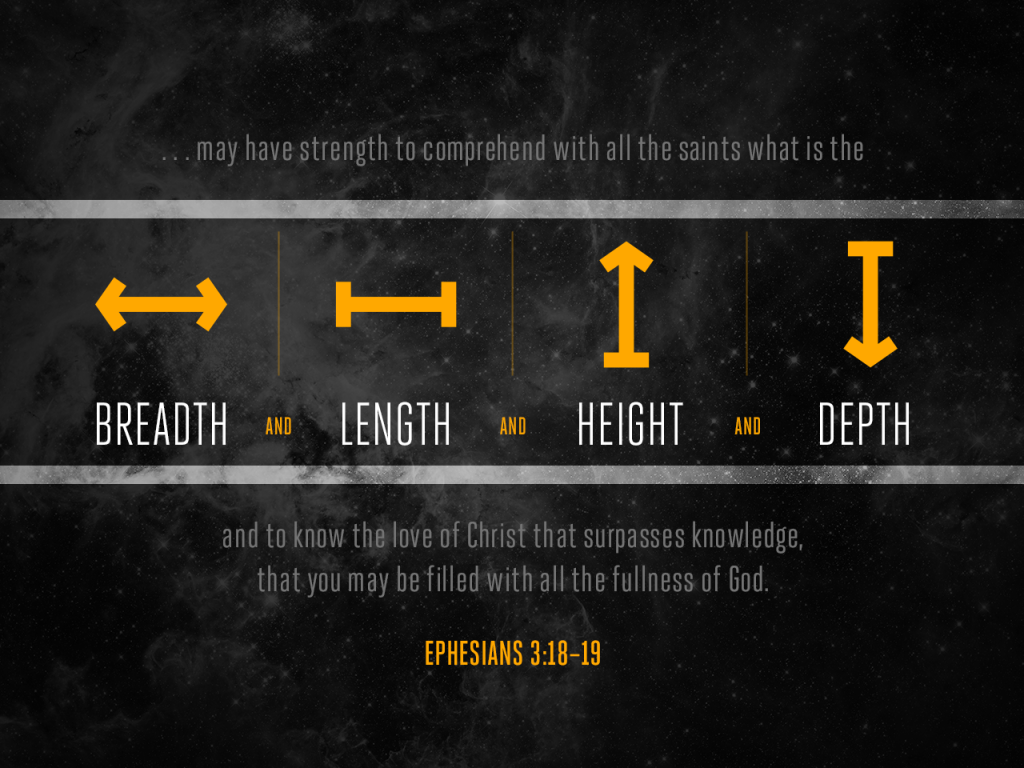Faithlife Study Bible (FSB) is your guide to the ancient world of the Old and New Testaments, with study notes and articles that draw from a wide range of academic research. FSB helps you learn how to think about interpretation methods and issues so that you can gain a deeper understanding of the text.
3:18 the breadth, and length, and height, and depth Evokes the boundless nature of Christ’s love.
3:19 surpasses knowledge The love of Christ is beyond human comprehension.
fullness of God This could refer to the blessings of God (1:3–8) or to His perfection and completeness. Compare note on Col 1:19.
Note
1:19 all the fullness to dwell in him Refers to God being fully present in Christ, parallel with Paul’s statement in 2:9. Consequently, Christ is sufficient for the Colossians’ salvation
This phrase echoes the glory of God filling of the tabernacle (Exod 40:34). In the ancient world, people believed that deities lived on high places such as mountains (see note on Gen 11:3).
For example, when the Israelites entered the wilderness, God met them on a mountain (Exod 19:3). But God did not stay on the mountain; He instructed the Israelites to build a tabernacle—a dwelling place for Him to live among His people (Exod 25:8).
God came down and filled the tabernacle with His glory as a sign of His presence among them (Exod 40:34). The prophet Isaiah interpreted this cloud of glory as the Holy Spirit (Isa 63:11). This gracious act was God’s extension of friendship to the Israelites (compare Exod 33:11).
The Gospel of John describes Christ as the tabernacle or the dwelling of God (John 1:14)—an allusion that demonstrates the continuity between God’s presence among the Israelites and His presence in the person of Christ.
Barry, J. D., Mangum, D., Brown, D. R., Heiser, M. S., Custis, M., Ritzema, E., Whitehead, M. M., Grigoni, M. R., & Bomar, D. (2012, 2016). Faithlife Study Bible (Eph 3:18–19). Lexham Press.
The Lexham Research Commentary is your starting point for study and research. It surveys all the relevant literature on a passage and brings the summary back to you. This guide summarizes a broad range of views on a particular passage—views you may or may not agree with, but in all cases, views you will encounter as you critically study the text.
The Fullness of God
In Ephesians 3:19 Paul prays that his readers’ knowledge of Christ’s love will result in their being filled (plēroō) with “the fullness of God” (to plērōma tou theou). The term plērōma appears in various ways in the nt, though it occurs most often in Paul’s letters. It is used in a simple sense to describe the amount of bread in the 12 baskets in the story of Jesus feeding 5,000 (Mark 6:43).
In Romans, Paul anticipates Israel’s resistance to the gospel will continue until “the full number of the Gentiles” (to plērōma tōn ethnōn) joins the people of God. Paul also refers to love as the “fullness” of the law (Rom 13:10). Paul writes that the birth of Christ occurred when the “fullness of time” (to plērōma tou chronou) came (Gal 4:4). And Colossians 2:9–10 contains a similar phrase with reference to Christ—“the fullness of deity” (to plērōma tēs theotētos).
Paul’s use of plērōma, along with its related verb plēroō, in Eph 3:19 raises several interpretive possibilities. The expression “the fullness of God” may express an ideal hope that the believer will one day be filled with the holiness and perfection of God.
Alternatively, it may refer to a believer growing to full maturity in Christ, or it may describe the spiritual blessings God grants believers in the heavenly places (Eph 1:3). Among several additional possible interpretations, Lincoln (1990, 214) argues that plērōma refers to God’s “presence and power, his life and rule,” which is immanent in creation and mediated in the believer’s life through the Spirit.
• Arnold maintains that “the fullness of God” is coextensive with the presence of the Holy Spirit. Arnold reads Ephesians 3:19 in light of the use of Isaiah in the affirmation of Eph 2:11–12: “The Lord is near.” Accordingly, Paul’s prayer in Eph 3 is that believers will experience the divine presence in its full measure.
• Paying close attention to the preposition eis (“to”) in Eph 3:19, Best argues that believers are not filled with the fullness of God in a direct sense. Rather, Best suggests, believers are filled with the same thing that fills God Himself: His love. He compares this to Paul’s later exhortation to imitate God, which comes in a context of love (Eph 5:1–2).
• Carson paraphrases being “filled up to all the fullness of God” as Paul saying “be all that God wants you to be.” He cites Ephesians 4:12–13 and explains that “the fullness of God” refers to spiritual maturity. According to Carson, this passage (Eph 3:14–19) implies that believers cannot be spiritually mature unless God’s power enables them to grasp the unfathomable dimensions of Christ’s love.
• In his dictionary article on Paul’s use of plērōma language, Lim suggests Eph 3:19 refers to believers’ growth until they reach the fullness of God. He examines the term in Eph 1:22, where it refers to the Church as “the fullness of Christ.” In Lim’s view, this refers to the Church being filled by Christ. He also addresses Eph 4:13, where the term describes the “full realization of the unity of all believers in Christ.”
• O’Brien interprets “the fullness of God” in terms of divine holiness since God and Christ are the standard for believers. As believers are filled with God’s presence, they will receive the full measure of spiritual maturity.
• Snodgrass, noting the close connection of this passage to Col 1:19 and Col 2:9, interprets “the fullness of God” as a description of how God makes His presence and power known to believers as they are made full by Christ and His love. Citing Colossians 2:9–10, he writes, “God’s fullness dwells in Christ and in him Christians are made full.” Snodgrass points out that Eph 5:1–2 expresses this same thought as an imperative.
• Thielman reads Ephesians 3:19 with Eph 4:13, where Paul refers to “the fullness of Christ.” He therefore argues that Eph 3:19 envisions believers maturing until they reach the fullness for which God created them—that is, the perfection of God.
Brown, D. R., Custis, M., & Whitehead, M. M. (2013). Ephesians (D. Mangum, Ed.; Eph 3:19). Lexham Press.







